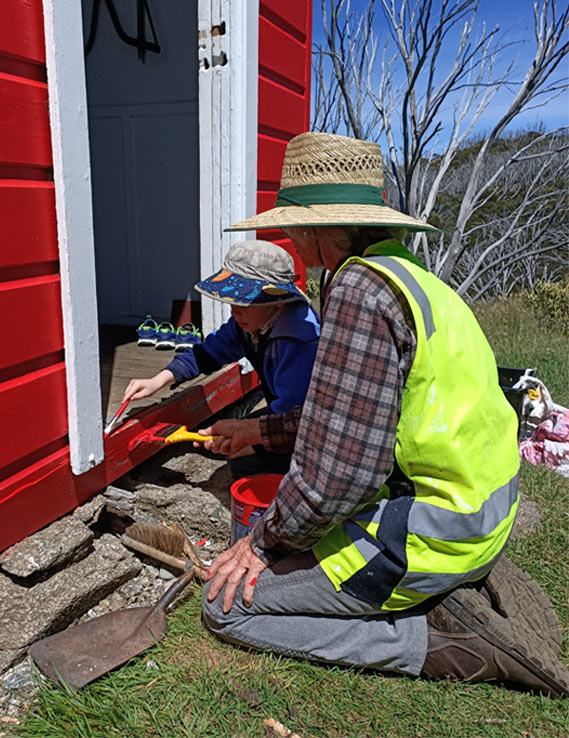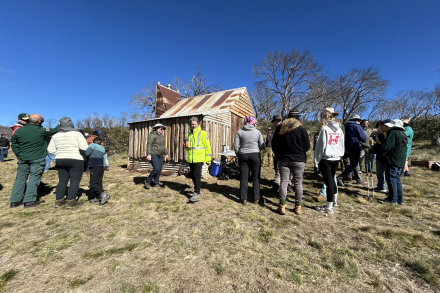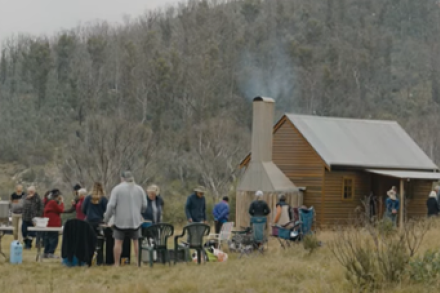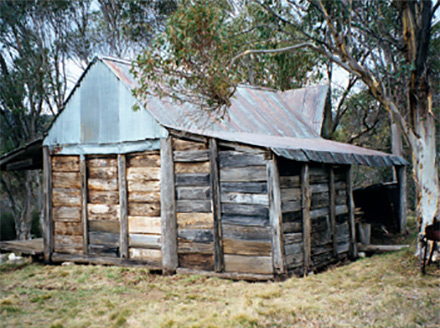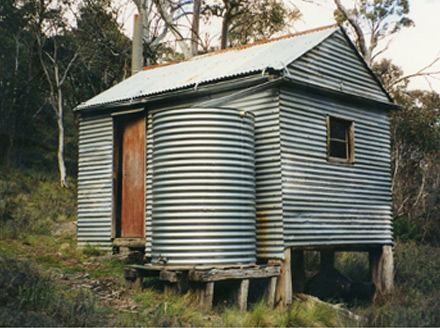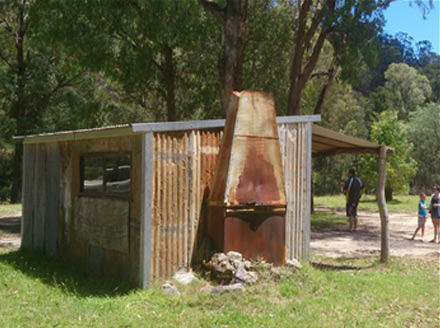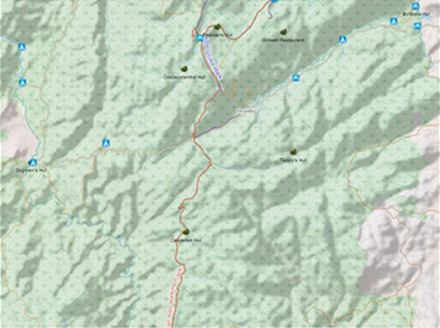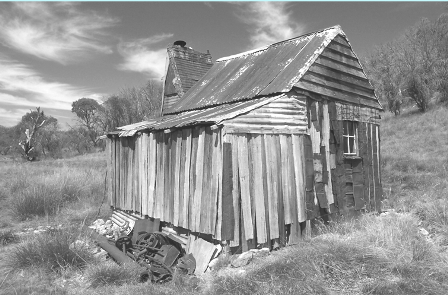 In this excerpt from the article originally published in WILD Magazine No 138 p54.
In this excerpt from the article originally published in WILD Magazine No 138 p54.
Ricky French, a New Zealand freelance writer.
He interviews KHA President Barbara Seymour and Life Member Klaus Hueneke AM.
That's not to say that Australia doesn't have its own love-affair with huts, it's just that the relationship is more nostalgic. Klaus Hueneke is one of Australia's most knowledgeable authorities on huts in the NSW and Victorian high-country...
His 1982 book Huts of the High Country is considered something of a bible amongst walkers. He followed up twenty years later with Huts in the Victorian Alps and continues to write and publish many books and journals on the Australian outdoors. As well as serving to provide historical facts and autobiographical information on the huts, the books Hueneke writes give a sense of his emotional connection to the outdoors, and the huts are in a sense his spiritual home. He calls his van his 'hut on wheels' and you could almost say that huts are his chapels of the outdoors. Hueneke almost says it. 'At this more spiritual level the Alps have become the eye of the needle through which my soul has passed to be integrated and born into a new reality. The huts become repositories of history, folklore and shared experiences.' But according to Hueneke that's not what comes first. He spoke to me on the phone from his home near Canberra, at the foot of his beloved Snowy Mountains. 'For me, huts are about survival, number one. Shelter from the cold, a place to light a fire, the basic stuff. The history is secondary.'
History, though, was a major weapon used by Hueneke and others such as the Kosciusko Huts Association in their early fights to save many huts in the Alps. 'When we were fighting to preserve the huts the only peg we could hang the argument on was history and heritage. When I started hiking in the 70s very little was known about the huts of the high country. So we started seeking out the people would built them, and recording their oral histories because I knew the more history we had the more likely we were to able to preserve the huts.' By 1995 Hueneke had four indexed volumes of Kosciuszko oral history at the National Library.
Natural attrition has also played a role. Bush fires in 2003 destroyed over 20 huts in NSW and 40 in Victoria. Hueneke claims this provided a catalyst for the Victorian and NSW governments, and they started to allocate funds for the restoration of huts. At Kosciuszko they put up half a million dollars to rebuild about ten of them. These days Hueneke is happy with the funding and resources dedicated to maintaining huts in the Alps. 'Countless huts have been restored and are being continuously maintained,' he says. 'Personally I don't want to see great improvement in the huts. I subscribe to the history argument - that the huts should stay the way they are.'
This view is quite surprising, given the history in the Kosciuszko area, where funding has traditionally been scarce, and huts have faced a bleak future due to past prevailing attitudes. A brief history: Huts were built throughout the 19th and 20th centuries by graziers, cattlemen, farmers, prospectors, and later by ski tourers. Most were private or had been in one family for generations. With the formation of the National Parks and Wildlife Service (NPWS) in 1967, control was passed to the government, and a clash of values began to emerge. NPWS didn't recognise the value or usefulness of many of the huts, and they were lobbied by many 'Wilderness' groups who didn't want any huts or other signs of human intrusion into what they thought were wilderness areas. (Cue the many arguments of what actually constitutes a wilderness area, given the hundreds and sometimes thousands of years in which humans have occupied and altered the land.)
The threat (and reality) of the huts' removal spurned the formation of the Kosciuszko Huts Association (KHA) in 1971, a volunteer organisation to promote the preservation and heritage of the high country through conserving historical huts. According to a 1976 KHA newsletter an unnamed 'wilderness advocate' argued that, 'Huts are alien to wilderness and the argument of huts for safety is spurious...if they are removed then those that enter (the bush) either survive or perish, which is what wilderness is all about.' Many huts were subsequently removed, and in one case a ranger burned down a hut.
The KHA locked horns with NPWS for the best part of twenty years, and when the NPWS proposed to remove most huts in the summit area and the White's River Corridor a grand stoush went down, resulting in the majority of the huts being granted a second chance. Momentum continued throughout the 1990s with working bees to restore historic huts and the publication of many social history books by the KHA, often with memorable titles such as 'If I Wake in the Middle of the Night,' and 'If That Man Comes Here I'll Shoot Him.' The frontier boundaries were set. It is noteworthy that at this precise time that people were battling to save a handful relics in the NSW Alps the Forest Service in New Zealand was in the middle of building its 644 new huts.
Barbara Seymour, president of the KHA, says there are seven areas listed as 'wilderness' within the Kosciusko National Park, and most of the remaining huts are located in those areas. She says no one really knows what the landscape was like before human occupation in these wilderness areas. 'I see no dividing line between the conservation of an area and its human history.' The KHA is a broad church, she says; its 400 plus members coming from a range of interest groups including skiers, bushwalkers, 4-wheel drive clubs, horse riders and NPWS personnel. 'All these members have would have a great deal of appreciation for the environment and would also view the presence of the huts within that environment as complementary to the overall landscape,' she says.
Slowly attitudes changed and an almost universal belief that historic huts should be left for the use and enjoyment of visitors prevailed. The KHA restored and re-built huts until the terrible fires of 2003. Work rebuilding those huts continues today. Raging infernos destroying everything in their path is one enemy New Zealand huts rarely have to contend with. The 2003 fires also saw the formation of the Victorian High Country Huts Association (VHCHA) who now do a similar job to that of the KHA. As Hueneke says in 'Huts of the Victorian Alps,' 'They say that fire cleanses and that good things can rise phoenix-like from the ashes. Well, they have.'
One conclusion that can be drawn is that there is a world of difference between New Zealand and Australia when it comes to the meaning of the word 'hut.' The Australian's scepticism for huts ever being used as primary accommodation is caused because they have never seen what a hut could be. The Australian hiker knows a hut as being ancient, run-down, dirty, beyond basic, a quaint peek at old-time life: at best a worthy piece of history deserving of respect. That hiker is unlikely to get excited about any move to build new huts: it's simply not part of the culture.
The Kiwi tramper has a higher expectation for their outdoors amenities. Warm, weather-proof huts are not just desirable, they are expected.
The fact tramping has always been a pastime that defines the New Zealand recreational spirit lies at the heart of this. New Zealand's international tourism marketing focuses on drawing travellers to the snowfields, the volcanoes, the white-water and also the Great Walks - nine heavily-trodden paths through which the best huts are laid out, and charged accordingly. The huts on these walks need to be booked and can cost up to $54 a night. Australia's outdoors marketing tends to focus to hotel-style accommodation on the fringes, although tracks such as the Overland Track in Tasmania are going down the New Zealand model, with more comfortable huts being made available.
There is an expectation that DOC will continue to fund and maintain these huts to a high standard. Any attempt to remove huts or cut funding to certain areas has been met with fierce opposition from the passionate, outdoors-loving public. In terms of public expectation for a government department to provide a service, you could compare DOC with the ABC in Australia. Both departments are watched by a hawk-like public, determined to see the values upheld. The department itself becomes a face, reflected in New Zealand catch-cry of 'What's up, DOC?' whenever a controversial decision is made.
Back when I was ten we had used the old Waitewaewae Hut in the Australian sense of the word: as a refuge, emergency accommodation, a place slightly drier than the outside world, better than nothing. Now, when I recall my fondest memories of tramping I find they usually involve sighting a hut materialising through the mist. A place to shut the door on the storm and open the whisky. To claim your bunk and unfurl your sleeping bag; to sit and read the hut book, light the stove and build a fire. A promise of warmth, a place to spread your mess and throw your battered bodies, the world on hold, the soul at rest.
Reprinted with the permission of
Carlie Trotter at primecreative.com Four Mile Hut - photo: Barbara Seymour




